|
|
|
Sort Order |
|
|
|
Items / Page
|
|
|
|
|
|
|
| Srl | Item |
| 1 |
ID:
170765
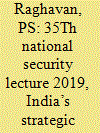

|
|
|
|
|
| Summary/Abstract |
We live in a world in which a post-cold war order is still in the making, as the sole super power shares the global stage with multiple state actors of varying weights, jostling for space to assert their national aspirations.
In this complex environment, India’s foreign policy seeks to maximise India’s political and economic space to further its global ambitions. This includes sustaining the vibrant India-US strategic partnership, forged since the early 2000’s, even while preserving the traditionally strong relationship with Russia from the decades of the Cold War. A comprehensive partnership has also been developed with China, though recent differences have somewhat dimmed its intensity. India needs a combination of domestic capacity building and external partnerships to reconcile the contradictory pulls of strategic cooperation and competition with China. Relations with the US, Russia, Japan and Europe are also elements of this effort. India’s multilateral activism in G-20, BRICS and SCO serve to enhance its room for manoeuvre in the dynamics of the US, Russia, China triangle. India’s strategy in the India-Pacific seeks to promote bilateral, plurilateral and multilateral partnerships in search for a cooperative and sustainable architecture in the region that promotes objective of a multi-polar order.
|
|
|
|
|
|
|
|
|
|
|
|
|
|
|
|
| 2 |
ID:
170762
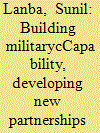

|
|
|
|
|
| Summary/Abstract |
The strategic need for nations to protect and promote their national interest in a changing world order has been the centre piece of global strategic discourse for some time. Linked to this aspect of national interest is the need to build military capability to prepare for the array of security challenges that lie ahead and also developing new partnerships, as the global order shifts from a unipolar model to a multipolar one. There is little dispute over the assertion that the world today is characterised by multi-layered and multi-faceted diversity from political, demographic, economic, environmental and strategic viewpoints. These issues are important from strategic perspective largely because it seems that the world is in another period of historical transition. It would be a fair assumption that we are living through a period of ‘strategic uncertainty
|
|
|
|
|
|
|
|
|
|
|
|
|
|
|
|
| 3 |
ID:
170764
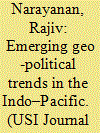

|
|
|
|
|
| Summary/Abstract |
The Indo-Pacific Region (IPR) is witnessing a major flux in the geo-political and geo-strategic spheres as there is a gradual shift in the maritime trade centre of gravity towards IPR from the Atlantic and the Pacific Regions. With the West and the USA perceived to be in a strategic retreat, it opens a window of opportunity in the region for a geo-strategic reconstruct. China, the resident major power, is keen to seize this opportunity to gain influence in the region. Xi Jinping sees this geo-political flux as an opportunity for China to assert itself within the Indo-Pacific. Towards that end, he has clubbed the existing infrastructure projects, and added a few, under the much touted ‘Belt Road Initiative (BRI)’ with the aim of gaining geopolitical space in Asia.
The article provides an analysis of the US and the Chinese strategies and the emerging trends for the Indo-Pacific and their implications for India and the way ahead.
|
|
|
|
|
|
|
|
|
|
|
|
|
|
|
|
| 4 |
ID:
170767
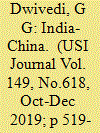

|
|
|
|
|
| Summary/Abstract |
Given the divergent national interests and complex outstanding issues between India and China, ‘one on one’ informal summits format adopted by PM Modi and President Xi has definitely contributed towards keeping the bilateral relations on track. The first such summit was held at Wuhan in China on 27-28 April 2018. Its key outcome was putting in place a process of bilateralism to facilitate strategic communication at the highest level and building mutual trust – ‘wuhan Spirit’. The summit also sought to provide ‘strategic guidance’ to the respective militaries to enhance cooperation for effective border management.
The second summit was held on 11-12 October 2019 at Mamallapuram, with focus on restoration of ‘Wuhan Spirit’, revamping the process of strategic communication and lending impetus to the mechanism of strategic guidance. President Xi laid down ‘100 year plan’ to rejuvenate the relations between two neighbours, signifying incremental approach to narrow the existing divide. He made six specific proposals seeking both sides to correctly view each other’s development and enhance mutual trust.
Relations between Delhi and Beijing transcend bilateral bounds and have strategic significance with far reaching ramifications. Real challenge for the two is to keep contentious issues at bay and yet, enlarge the area of cooperation. Informal dialogue between the top leaders offers an excellent platform to this end. While reimagining ‘new era of cooperation’, India must be forth right in safeguarding its national objectives as Chinese are ardent practitioners of realpolitik.
|
|
|
|
|
|
|
|
|
|
|
|
|
|
|
|
| 5 |
ID:
170769


|
|
|
|
|
| Summary/Abstract |
The initiative taken by China to revive discussions on “The India-Pakistan Question”, which had been lying dormant on the agenda of the United Nations Security Council (UNSC) since December 1971, has potentially significant implications for India. This article looks at the details of “The India-Pakistan Question”, including the manner in which the UNSC twisted India’s complaint against Pakistani aggression on India’s territory in Jammu and Kashmir to broaden the scope to apply the “two-nation theory” on the basis of which the United Kingdom had partitioned British India and re-opened the accession of the Princely State of Jammu and Kashmir to India. The UNSC acknowledged that its resolutions failed to be implemented due to the inability of the Security Council to vacate the Pakistani aggression on India.
China (represented permanently in the UNSC by the Republic of China (ROC) till October 1971) was party to UNSC resolutions on “The India-Pakistan Question”. China did not adopt an activist role in drafting these resolutions between January 1948 to October 1971. After the unseating of the ROC from the UNSC and its replacement by the People’s Republic of China (PRC) in October 1971, an assertive China tried to use “The India-Pakistan Question” to counter India’s actions during the December 1971 India-Pakistan war which led to the independence of Bangladesh. The PRC cast its first veto against the admission of Bangladesh to the UN in August 1972.
UNSC resolutions on this issue were overtaken by the bilateral treaty signed between India and Pakistan at Simla in July 1972. China’s latest diplomatic initiative on this subject goes against five decades of inactivity of the UNSC on “The India-Pakistan Question”. It presages China’s attempt to use her permanent membership of the UNSC to exploit “The India-Pakistan Question” as a negotiating tactic to retain Chinese occupation of India’s territory in Jammu and Kashmir.
|
|
|
|
|
|
|
|
|
|
|
|
|
|
|
|
| 6 |
ID:
170763


|
|
|
|
|
| Summary/Abstract |
ension in and around the Persian Gulf is on the rise and any conflict involving Iran would be devastating for the region and harmful for the global economy. Economic sanctions imposed by the US on Iran have inflicted considerable damage to its economy. These sanctions came into full force in May 2019 and coincidentally, since then the region has been witnessing attacks on the energy sector through damage to maritime transportation and onshore assets. These attacks, some of which have been highly sophisticated, and the lack of effective US response has led to considerable reassessment. With the re-imposition of US sanctions, Iran is also no longer keeping its nuclear development programme on hold. While Iran may generally not confront the US directly, it may create considerable difficulties for other Gulf states. In the vitiated atmosphere that exists in the region, accidents can occur leading to the situation spiralling out of control and causing enormous harm globally. Priority should be accorded to avoiding any conflict in the Gulf. Iran can withstand the sanctions and deal with internal dissent. Nevertheless, with a view to find a way out, President Rouhani unveiled the Hormuz Peace Endeavour (HOPE) in the UN in September 2019. President Macron of France too has made considerable efforts to launch confidence-building interactions between Iran and the US. Given that peace and stability in the Gulf region are in its strategic interest, India should play a proactive role, along with other like-minded countries, to promote this.
|
|
|
|
|
|
|
|
|
|
|
|
|
|
|
|
| 7 |
ID:
170771
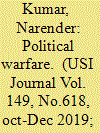

|
|
|
|
|
| Summary/Abstract |
Political warfare is emerging as a preferred tool to fight modern wars. It provides deniability and scope to turn social, political and religious fault-lines into belligerent forces to fight from within. The collapse of regimes, and even states, is a possibility. However, it is difficult to predict the end state or outcome of the war. To fight and defend against such a threat, there is a need for heavy investment in intelligence operations. Best defence is to make institutions of governance and civil society so robust that they do not succumb to the directed attacks by multiple agents of political warfare.
|
|
|
|
|
|
|
|
|
|
|
|
|
|
|
|
| 8 |
ID:
170773
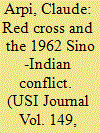

|
|
|
|
|
| Summary/Abstract |
For the Indian nation, the 1962 conflict with China has been one of the most traumatic post-independence events. For more than 3,000 prisoners of war (PoWs), the experience was particularly harrowing.
This article looks at difficult relations between the International Committee of the Red Cross (ICRC) in Geneva, the Indian Red Cross (IRC) and the Chinese Red Cross (CRC) Society. The ICRC’s archives in Geneva helped to understand the role of the international organization as well as of the two national Red Crosses and their respective governments during the conflict.
China not only refused to officially acknowledge the Geneva Convention of 1949 on PoWs, but also committed several violations in respect of the treatment meted out to captured Indian military personnel.
27 Military officers taken PoWs during operations were taken on a tour of china and repatriated on 04 May 1963.
The rosy picture painted by the Chinese propaganda had actually been a traumatic experience for the Indian PoWs.
|
|
|
|
|
|
|
|
|
|
|
|
|
|
|
|
| 9 |
ID:
170772
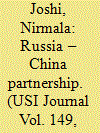

|
|
|
|
|
| Summary/Abstract |
The huge Eurasian landmass began to attract world attention after the breakup of the Soviet Union in 1991. The Eurasian landmass is not only a vast storehouse of natural resources and precious minerals, but importantly two potential leading powers; the Russian Federation and the Peoples Republic of China are also located in Eurasia. Today, Eurasia is a witness to ongoing interplay of cooperative and competitive tendencies among the powers. A predominant factor of present day Eurasian politics is the strong partnership between former rivals; Russia and China. The partnership has elicited divergent views both at the official and non-official levels. The article attempts to understand the evolving engagement between Russia and China in terms of cooperation and competition.
|
|
|
|
|
|
|
|
|
|
|
|
|
|
|
|
| 10 |
ID:
170766


|
|
|
|
|
| Summary/Abstract |
Over 8,000 satellites, or manmade objects, have been launched till date with nearly 5,000, belonging to 50 countries, still in orbit and nearly half of those are actually operational. Spacecraft have done soft or hard landings on or done flybys of many terrestrial bodies within the solar system, including on Asteroids and Comets. American and Chinese private space companies are part of the ultimate goal of enabling people to live on other planets. Space warfare is combat that may take place in outer space. It includes attacking objects in space from the Earth, or from another space platform. Till date, no actual war has ever taken place in space, though a number of tests and demonstrations have been performed. International treaties are in place that regulate conflicts in space and limit the installation of space weapon systems, especially nuclear. Major powers have space warfare organisational structures. Many countries have developed and tested space weapon systems ranging from anti-satellite missiles, Railguns, and very small highly mobile satellites nimble enough to manoeuvre around and interact with other orbiting objects to sabotage, hijack, or simply collide with them. Directed Energy Weapons (DEWs) would include lasers, linear particle accelerators, or plasma based weaponry. With an eye on growing space capabilities of China, India has been slowly building its capabilities in space. India has tested its anti-ballistic missile (ABM) defence systems and achieved many other key milestones pertaining to space, including the demonstration of India’s anti-satellite (ASAT) capability and establishment of the new tri-service Defence Space Agency (DSA). The thin line dividing the earth’s atmosphere and space is fast shrinking with more platforms transiting between earth and terrestrial locations. Is India prepared and what is its road map ahead is a subject being debated among military and scientific community.
|
|
|
|
|
|
|
|
|
|
|
|
|
|
|
|
| 11 |
ID:
170768


|
|
|
|
|
| Summary/Abstract |
The paper starts with a section which briefly outlines the operating environment the Army is likely to operate in, emphasising the aspects of enhanced mobility, lethality and small enemy fighting groups of a nation state or trans-border terrorists or hybrid of the two.
In the next section, there is a brief expose on the evolution of network centricity and a listing of the military relevant new age technologies that are emerging.
The paper goes on to examine the objective and capability enhancements that will be required to thwart the enemy designs on the battlefield, counter use of emerging technologies, present adversaries with multiple dilemmas and beat the enemy. The five capability enhancement areas are – situational awareness, physical and cognitive load, sustainability, mobility and manoeuvre, protection of the force and common control.
The next section identifies relevant segments of technology, formed by combination of earlier listed technologies, to achieve the identified enhancements required. These segments are – Artificial Intelligence, Autonomous Robotics, common controls and secure data communications. The need for evolving a simultaneous conceptual framework is also covered briefly.
The paper lays down short, medium and long term time lines and spells out some of the recommended activities in each phase. A cycle of ideate, research, test, accept / reject, centre of excellence (CoE), productise is introduced that obliquely refers to make in India. Importance of innovation and creative thinking leading to productisation is emphasised.
In the last section, an attempt is made to identify major stake holders from army, academia and industry to take the concept forward in a collaborative, inclusive and adaptive manner by instituting regulation, control and execution layers. A recommendation to set up multi domain joint interest groups under this mandate is made.
|
|
|
|
|
|
|
|
|
|
|
|
|
|
|
|
| 12 |
ID:
170770


|
|
|
|
|
| Summary/Abstract |
Defence cooperation is an important part of the overall peace measures, contributing to improvement in national security. There have been a number of books and essays highlighting achievements of defence cooperation, but scope for achieveing more comprehensive security is there. Through analysis, this article focuses on contribution of defence cooperation with neighbouring countries and some major powers towards Vietnam’s national security during the Renovation (Doi Moi) period.
|
|
|
|
|
|
|
|
|
|
|
|
|
|
|
|
|
|
|
|
|